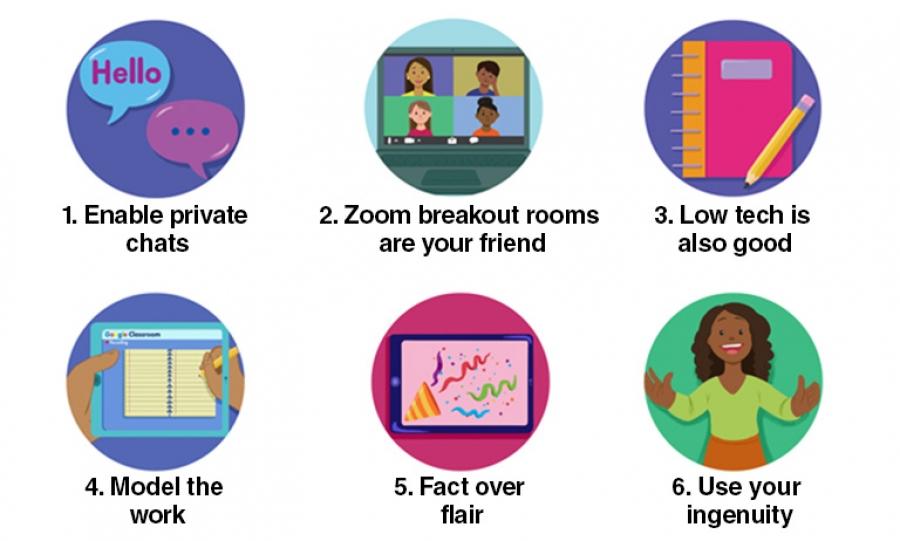Jamala Roper is used to giving high fives to her 5th-grade students.
“I love engaging students in a way that validates them,” says Roper, a literacy teacher at PS 179 in the Mott Haven area of the Bronx.
Because of social-distancing guidelines, high fives and hugs aren’t possible in Roper’s classroom this year. So she and her students are finding creative ways to interact when they are together, but apart.
“I tell them to ‘catch my hug,’ and I extend my arms and they hug themselves,” she says. “I’m making sure they feel uplifted and get a little love from me even though I can’t touch them.”
Teachers across New York City are revising their routines and reshaping their instructional practices this school year.
If experimenting with new strategies pushes you out of your comfort zone, you’re not alone. “Some days I feel like a rock star, other days I feel like a complete failure,” says Kimberly Falco, a 3rd-grade teacher at PS 213 in Bayside, Queens.
But, just as in a typical school year, even small adjustments can help teachers strike the right note for their students.
1. Enable private chats
Falco, whose students are fully remote, says that configuring her virtual chat feature differently in Zoom has had surprising benefits.
“Children can only chat with the host. That gives students an avenue to participate even if they’re shy,” she says. “They know it’s private, and it gives them the autonomy to advocate for themselves if they need help. I have students who participate only in the chat, and I’m shocked by how much they know.”
2. Zoom breakout rooms are your friend
Falco and her colleagues also say it works for them to remain in a Zoom session with their class while students work independently.
“Our philosophy as a team is that when you teach a lesson in the classroom and then you send children off to do independent work, you don’t walk out of the classroom,” she says.
They use Zoom’s breakout rooms to pull small groups during that time.
Amy Crehore, a 5th-grade dual-language teacher at Samara Community School in the Morrisania area of the Bronx, uses the same approach.
“It mimics the real classroom experience and gives me time to help students in the moment,” she says.
Crehore has also found success assigning students to individual breakout rooms of their own so she can hold one-on-one conferences with them during independent writing.
3. Low tech is also good
Students and teachers are relying on digital tools more than ever this school year. But Tiffany Helmy, a 3rd-grade teacher at PS 748 in Bensonhurst, Brooklyn, says that even though her students are fully remote, she strives for low-tech assignments whenever possible.
“Although we’re home, I wanted to make it as similar to the classroom as possible. So I ask them to work out of their notebooks 80% of the time,” she says.
4. Model the work
Helmy uses her classroom’s document camera to display her own model notebook to her students. Then she takes a picture of her notebook and uploads it to her Google Classroom so students can see the “intended outcome” while they work independently — the same way an anchor chart would function in a classroom.
5. Fact over flair
For teachers who are using digital resources with their students, Jillian Ehlers, a librarian at the Metropolitan Expeditionary Learning School in Forest Hills, Queens, emphasizes the importance of “fact before flair.”
“Yes, we want students to create beautiful projects online, but let’s talk about the skills they need in order to accomplish that task,” she says. “We don’t want to use digital tools just because they’re cool, but because they’re actually building information in digital literacy.”
Ehlers suggests concentrating on just one or two versatile resources — like Flipgrid and Padlet — that students can use in different ways, then honing both the technical and the curricular knowledge they’ll need to use them successfully.
“The librarian in your school can support you with digital resources and tech tutorials,” she says.
6. Use your ingenuity
Finally, there’s no substitute for old-fashioned ingenuity. Roper and her 5th-graders hit on a way to transform a drawback to wearing masks — their struggle to read each other’s facial expressions — into a learning experience.
“I do a lot of pantomiming; I have to be beyond dramatic because they can’t see my mouth,” she says. “‘Look at my eyes and my body language; what can you infer about my emotions right now?’ Then I say, ‘Hold onto that thought and pass it to your partner across the room.’ Then they’re accountable to their partner who’s looking at them even though they can’t sit together, and they get so hyped about that because they think they’re reading each other’s minds.”
